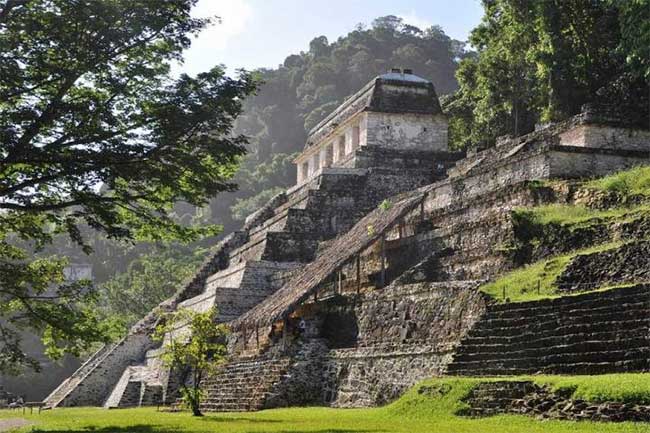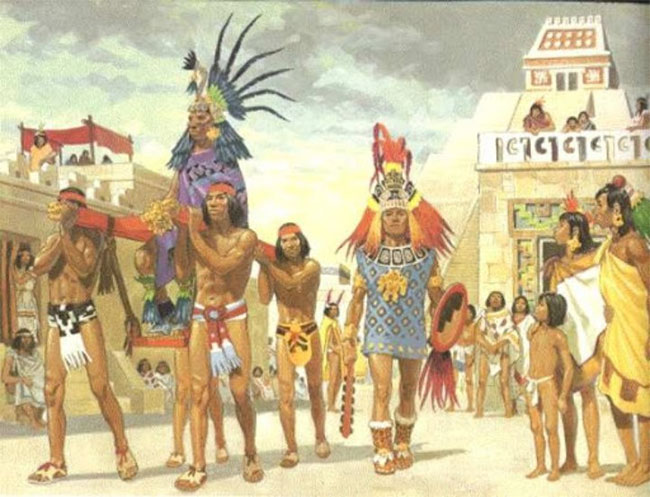Who are the Mayans, Incas, and Aztecs?
The Mayans, Incas, and Aztecs created three powerful ancient civilizations, existing in Mexico and throughout South America hundreds, or thousands of years ago.
Mayans
The oldest of these is the Mayans, who once lived on the Yucatan Peninsula. Their name comes from the city of Mayapan, a place in ancient Yucatan. The Maya lived in both agricultural villages and cities in Central America nearly 3000 years ago (starting around 250 AD). They built great pyramids (you didn't hear them wrong, Egypt is not the only place where there are pyramids!) And large buildings (called plaza) made of giant stone pillars.
The material the Mayans used to build all of their magnificent structures was taken from the limestone quarries of the Yucatan Peninsula. The volcanoes in the southern part of the island produce a rich volcanic soil, extremely suitable for agriculture. Mayan land spread from Mexico to Central America.

Mayan pyramids.
Despite being an ancient civilization , the Mayans still survive today in the areas where their ancestors lived. Many of these still speak the ancient Mayan language. At times there were rumors that Maya civilization had completely disappeared, but that was incorrect. Although life may not be the same today, many modern Mayans perform rituals identical to their ancestors.
You may have heard the mysteries in Maya culture, usually revolving around the time the calendar system they created came to an end on December 21, 2012. Many believe that it is a warning sign of the end of the world, but ultimately we still survive. Why? Because the Mayan calendar doesn't really end on that day.
The Maya have their own belief system, starting with the notion that nothing is born and nothing dies. When you "die", you still live, just go on. They have temples dedicated to their own gods, as well as concepts related to "hell" and "heaven".
The Maya have a government and kings. Their civilization is divided into cities. They have the law, but there is no prison. Instead of being imprisoned, prisoners will be tried and punished in one of the following ways:
- 1. Forced to pay a fine
- 2. Being turned into a slave
- 3. Being insulted
- 4. Being executed to death
The Incas
The Incas built an empire in Peru around 1200 , and they developed over 300 years later. Although the Incas no longer exist, their modern-day ancestors in Peru performed many cultural rituals learned from their predecessors.
If you come to Peru, you will feel like you are coming back to the Inca period when you see their stone constructions, as well as discover the silk weaving culture that has been passed down from ancient generations. Although the Spaniards invaded the Incas in 1523, their stories and lifestyles are not erased from history. The Spaniards have preserved the art, culture, and events of the Incas to this day.

Machu Picchu relics.
One place you definitely must visit if you want to learn Inca history is Machu Picchu. It was a stronghold, the former residence of the Inca ruler, Pachacutec Inca Yupanqui. Machu Picchu is located on a mountain, built in the 15th century but it was not discovered in 1911. Inca is probably the largest empire ever to exist in the Americas.
The Incas had a strong military force, and the government exercised rulers on the people. Like modern society, they set laws that must be followed. They have their own languages and calendar system. Many Peruvians still speak Quechua, the original language of the Incas.
You may think that roads are the only thing existing in modern society, the Inca empire built thousands of miles of roads, bridges, and tunnels. To curb famine, the Incas developed irrigation systems to bring water into farms that were located in hilly areas.
Aztecs
The Aztecs are perhaps the most colorful of the three ancient civilizations we mention here, in terms of works of art and statues. They lived in central Mexico from the 14th to 16th centuries . The capital of the Aztecs is Tenochtitlan, today Mexico City.
Like the Mayans and the Incas, the Aztecs had a rich agriculture . They planted corn, but also built magnificent temples like the Mayans and the Incas. Like the Incas, the Aztecs possessed a powerful army of warriors - conquerors, with the skills to help them win every battle.

The Aztecs themselves referred to themselves as Mexicans.
Although we call them " Aztec", the Aztecs themselves call themselves Mexicans. They speak Nahuatl, and in their Aboriginal language, the word "Aztec" describes people from the legendary Aztlan region of southern Mexico.
In the era of the Aztecs, royalty were the holders of the throne, and their empires were quite similar to those in European history. The Aztec people were racially diverse, but the government was not strictly regulated - in fact, the Aztec ruling system was inclined to pay tribute. They conquer neighboring countries and give these people a better life. However, it was accompanied by a rather terrifying custom: sacrificing people to live on all 18 annual holidays (Incas also had the practice of sacrificing the living, but not so much).
The Spaniards conquered the Aztecs in 1521, wiping them off the Earth's map. However, the Nahuatl language is still propagated by Mexican Indians, and the Aztec culture is preserved by their descendants. The Spanish conquerors stole Aztec treasures, which were later discovered in the ruins of the Aztec capital, today Mexico City.
Conclusion
From the treasure hunts, the ancient gods, the beautiful works of art, to the ancient ruins (with the top architecture that modern people also admire), the ancient civilizations The above mentioned has left a lot of valuable things for us to enjoy and learn. Perhaps the skills of building roads, houses, and agricultural structures that we modern people know are also inherited in part from ancient humans.
- The truth about the Indian sacrifice of sacrifices
- The Incas saw gold as the sweat of the Sun God
- The inscriptions of the Incas are hidden in knots
- Aztecs specialize in eating prisoners meat
- Ancient Mayans knew business?
- Horror burying the dead under the house of the Atzec
- Detected 33 mummies 600 years old
- Discovered ancient corpses in America
- Ancient Mayans also smoked
- How was the Egyptian pyramid built?
- The sacred book of the Mayans
- The wonderful beauty of the sacred valley of the Incas
 'Fine laughs' - Scary and painful torture in ancient times
'Fine laughs' - Scary and painful torture in ancient times The sequence of numbers 142857 of the Egyptian pyramids is known as the strangest number in the world - Why?
The sequence of numbers 142857 of the Egyptian pyramids is known as the strangest number in the world - Why? History of the iron
History of the iron What is alum?
What is alum? Laser reveals a series of 'haunted houses' of the Incas, invisible to the naked eye
Laser reveals a series of 'haunted houses' of the Incas, invisible to the naked eye  Decode leaves that are more precious than gold of the Inca empire
Decode leaves that are more precious than gold of the Inca empire  Amazing facts about the Incas
Amazing facts about the Incas  Discovered the last Inca emperor
Discovered the last Inca emperor  Civilization rises due to climate change
Civilization rises due to climate change 